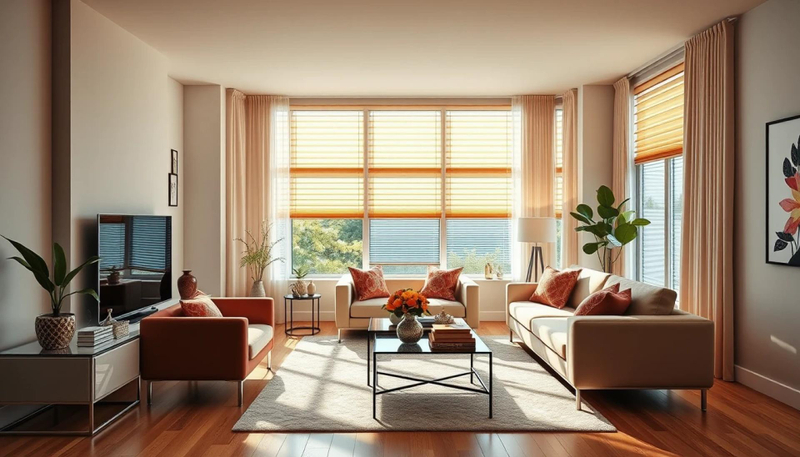Table of Content
- Introduction
- Cellular Shades (Honeycomb Blinds)
- Pleated Blinds
- Material Variations
- Choosing the Right Blinds for Your Home
- Conclusion
- FAQs
Have you ever walked into a room and instantly felt the cozy, energy-efficient vibe from the perfect window treatment? Whether you're revamping your home or simply curious about new trends, understanding the differences between cellular & pleated blinds is a game-changer. In this article, we’re going to dive into the world of blinds—from the intricacies of cellular shades (also known as honeycomb blinds) to the chic appeal of pleated styles. We’ll break down single-cell versus double-cell constructions, explore the unique characteristics of flat-fold, waterfall, and teardrop pleated blinds, and even take a peek at material variations like fabric types, textures, and opacity levels. And remember, if you’re in the market for quality window treatments, the name Avablinds might just pop up as your go-to option!
Cellular Shades (Honeycomb Blinds)
Cellular shades are much more than just a pretty face. Their honeycomb design isn’t just for looks—it’s engineered to trap air and provide excellent insulation. Whether you choose a single-cell or a double-cell construction, these blinds work hard to keep your home comfortable and energy-efficient.
Single-Cell Construction
Design and Functionality
Single-cell cellular shades are designed with one layer of cells that create pockets of air. Think of them as a single layer of cushioning for your windows! This design helps moderate indoor temperatures by reducing heat loss in the winter and keeping the space cooler in the summer. The lightweight design makes them easy to operate, ensuring a smooth and effortless user experience.
Pros and Cons
- Pros:
- Sleek and minimalistic design
- Generally more affordable than double-cell options
- Provides decent insulation for moderate climates
- Cons:
- Insulation efficiency may be lower compared to double-cell variants
- Less effective in extreme weather conditions
Double-Cell Construction
Enhanced Insulation
Double-cell cellular shades, as the name suggests, have two layers of cells. This additional cell layer acts as an extra buffer, trapping more air and boosting the blinds’ insulation capabilities. In colder months, this means less heat escapes from your home, while in the summer, it keeps the heat at bay. The result? Improved energy efficiency and potentially lower utility bills!
Performance Comparison
When you compare double-cell to single-cell, you’re really looking at enhanced performance. Although they tend to be a bit pricier, the added energy efficiency can be a smart long-term investment—especially in areas with more extreme temperatures.
Cellular Shades Construction Comparison Table
Feature
Single-Cell
Double-Cell
Insulation Efficiency
Moderate
High
Energy Efficiency
Good for mild climates
Ideal for extreme climates
Light Control
Adequate
Enhanced due to extra layering
Price Range
Budget-friendly
Higher initial cost but energy savings
Maintenance
Easy to clean and operate
Slightly more complex due to design
Pleated Blinds
Pleated blinds bring a touch of sophistication and modern design to your windows. Their unique folding pattern not only offers an attractive silhouette but also provides flexibility in controlling light and privacy. Let’s take a closer look at the three popular styles.
Flat-Fold Style
The flat-fold style is as straightforward as it gets. These blinds feature a crisp, even fold when raised, giving your windows a clean, contemporary look. Flat-fold blinds work great in minimalist settings where every design element is chosen with care. They’re also ideal for rooms where you want a subtle hint of texture without overwhelming the space.
Waterfall Style
Imagine a gentle cascade of fabric gently draping down your window—this is the waterfall style in a nutshell. Waterfall pleated blinds are designed to mimic the smooth flow of water, which creates a soft, graceful effect. They are perfect for spaces where you want to evoke a sense of tranquility and elegance. Plus, the layered design adds depth and interest to your decor.
Teardrop Style
The teardrop style offers a playful twist on traditional pleated blinds. With shapes reminiscent of delicate raindrops, these blinds add a whimsical charm to your interior design. They’re a fantastic choice if you’re aiming to create a light, airy atmosphere with a touch of personality. Teardrop blinds often catch the eye and can serve as a subtle focal point in any room.
Pleated Blinds Styles Comparison Table
Below is a comparison of the different pleated blinds styles. Notice that the heading for this table is bolded as per our guidelines.
Style
Characteristics
Best Use
Flat-Fold
Crisp, even folds; minimalistic design
Modern, minimalist interiors
Waterfall
Cascading fabric; soft, graceful appearance
Elegant spaces, living rooms, bedrooms
Teardrop
Unique, playful shapes; adds visual interest
Creative spaces, kitchens, accent areas
Material Variations
When choosing window treatments, the material variations play a huge role in the final look and functionality. From the feel of the fabric to the level of opacity, understanding these differences can help you select blinds that perfectly complement your lifestyle.
Fabric Types
Different fabric types lend different vibes to your room. Some blinds are made from woven fabrics that add a natural texture, while others use more synthetic materials for a modern, sleek finish. Your choice of fabric can affect not only the appearance but also the durability and maintenance of the blinds.
Textures
The texture of your blinds can dramatically alter the ambiance of your space. For example, a soft, matte finish might evoke a cozy, welcoming feel, while a glossy finish can bring a contemporary and polished look. It’s like choosing between a cotton sweater and a leather jacket for your windows—each offers its own unique flair.
Opacity Levels
One of the key decisions you’ll face is whether you want light-filtering or blackout options. This choice will directly impact the atmosphere in your room.
Light-Filtering Options
Light-filtering blinds allow a gentle diffusion of daylight, creating a warm, inviting glow without compromising your privacy. They’re ideal for living areas or dining rooms where you want natural light to create an upbeat ambiance. Plus, they still offer some protection against harsh sunlight, which can help in preserving your furnishings.
Blackout Options
If you’re looking to completely block out light—for instance, in bedrooms or media rooms—blackout options are the way to go. These blinds are designed with denser materials that ensure minimal light penetration. Not only do they provide maximum privacy, but they also help in creating a perfect environment for restful sleep or an immersive movie-watching experience.
Choosing the Right Blinds for Your Home
Deciding on the ideal window treatments can sometimes feel overwhelming. With so many options available, what factors should you consider to make the best choice? Let’s break down some key points that can help you decide.
Factors to Consider
When it comes to selecting between cellular and pleated blinds, consider the following:
- Insulation Needs: Do you live in an area with extreme temperatures? Double-cell cellular shades might be your best bet.
- Light Control: How much natural light do you want in your space? For a softer glow, light-filtering options are ideal; for complete darkness, blackout materials work wonders.
- Aesthetic Appeal: Consider the overall decor of your room. Sleek, modern spaces may benefit from flat-fold pleated blinds, while more eclectic interiors might shine with teardrop or waterfall styles.
- Budget: While cellular shades offer excellent energy efficiency, the double-cell versions can be a bit more expensive. Balance your needs with your budget.
Benefits of Quality Blinds
Quality window treatments do more than just cover your windows—they can transform a room. High-quality blinds help in reducing energy bills by providing insulation, offer versatility in light control, and add an extra layer of style to your interior décor. When you invest in well-made blinds, you’re investing in both functionality and aesthetics.
Why Avablinds?
When it comes to reliable, stylish, and efficient window treatments, Avablinds is a brand that stands out. With a wide range of options designed to suit every taste and budget, Avablinds brings innovation and quality together. Their commitment to craftsmanship means that whether you choose cellular or pleated blinds, you’re getting a product that’s built to last while enhancing the overall beauty of your home.
Conclusion
In a world where style meets functionality, understanding the nuances between cellular and pleated blinds can truly elevate your living space. From the energy-saving benefits of honeycomb blinds to the modern elegance of pleated styles, each option offers unique advantages that can cater to your specific needs. With careful consideration of factors such as insulation, light control, fabric type, and overall design, you can find the perfect match for your home décor. Ultimately, selecting the right window treatment is a personal journey that not only enhances the look of your space but also improves your everyday living experience. As you wrap up your search for the perfect window solutions, keep in mind that the subtle charm and energy efficiency of cellular & pleated blinds might be just what your home needs.
FAQs
- What are the main benefits of cellular shades?
Ans: Cellular shades are known for their energy efficiency, as their honeycomb design traps air and helps regulate indoor temperatures. They also offer a sleek design that suits various home decors.
- How do pleated blinds differ from traditional blinds?
Ans: Pleated blinds feature a unique folding design that gives a modern, artistic touch. They are available in several styles such as flat-fold, waterfall, and teardrop, each offering a distinct aesthetic appeal and light control option.
- Can I use cellular or pleated blinds in any room?
Ans: Absolutely! Cellular shades are great for areas where energy efficiency is a priority, while pleated blinds can enhance both modern and traditional interiors. The choice of fabric and opacity can be tailored to fit the needs of different rooms.
- What factors should I consider when choosing between single-cell and double-cell cellular shades?
Ans: Consider the climate of your area, your budget, and your desired level of insulation. Single-cell shades are lighter and more affordable, while double-cell shades provide enhanced insulation and energy efficiency.
- Why should I consider Avablinds for my window treatments?
Ans: Avablinds offers a diverse range of high-quality cellular and pleated blinds that combine functionality with style. Their products are designed to enhance energy efficiency, provide optimal light control, and complement any interior design—making them a reliable choice for modern homeowners.


